![]()
Dimethyltryptamine (DMT)
The so-called spirit molecule
![]()
Paul May
University of Bristol
(based on an original draft by Masoud Sadeghi)
![]()
Molecule of the Month September 2019
Also available: JSMol version.
![]()
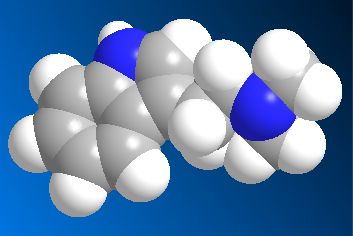
Dimethyltryptamine (DMT)The so-called spirit molecule
Paul May
Molecule of the Month September 2019
|
 |
Quite right! Many people might have heard of tryptamine as a neurotransmitter found in the brains of most mammals. It is structurally related to the amino acid tryptophan (MOTM June 2002), which is necessary for the production of several crucial substances in the body, including niacin (Vitamin B3, MOTM Jan 2019) and the neurotransmitter serotonin (MOTM April 2005). Because serotonin plays a key role in mood and sleep patterns, tryptophan supplements have been used for many years as antidepressants, weight-loss aids and as sleep aids.
 |
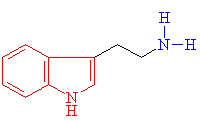 |
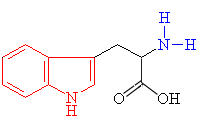 |
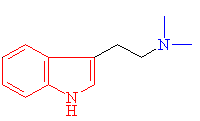 |
| Indole | Tryptamine The indole ring is shown in red, the ethyl in black and the amine in blue. |
Tryptophan | N,N-Dimethyltryptamine (DMT) |
Yes, DMT is one of a host of so-called substituted tryptamines, that are sometimes known as serotonin analogues. The important part of the tryptamine structure is the indole ring joined to an amino group via an ethyl sidechain. In substituted tryptamines, one or more of these component parts are modified by replacing another group for one of the hydrogen atoms. Because of its role as a neurotransmitter, modification of tryptamine often leads to molecules with a range of potent biochemical or psychotropic properties.
Well, the neurotransmitter serotonin itself is the obvious one; sometimes called the ‘molecule of happiness’, it has roles in the control of appetite, sleep, memory and learning, temperature regulation, mood, behaviour, cardiovascular function, muscle contraction, endocrine regulation and depression. Another derivative is melatonin (MOTM April 2000), a hormone involved in regulating the sleep-wake cycle. There is also psilocybin (MOTM October 1999), the active psychotropic ingredient in ‘magic mushrooms’, and mescaline the psychedelic drug in some cacti, as well as other synthetic hallucinogenic compounds such as LSD (MOTM December 1998) and the anti-addiction drug ibogaine (MOTM Sept 2002). Other synthetic derivatives of tryptamine also include the anti-migraine drugs Sumatriptan (Imitrex) and Zolmitriptan (Zomig).
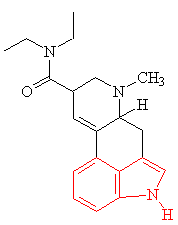 |
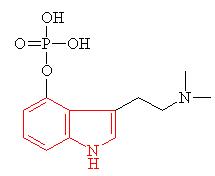 |
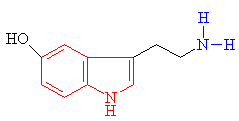 |
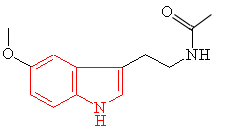 |
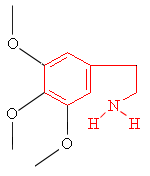 |
| Lysergic acid diethylamide - LSD The indole ring is highlighted in red. |
Psilocybin | Serotonin | Melatonin | Mescaline |
Yes, and has been used by tribes in the Amazon for centuries in their religious rituals. It is found as a constituent in a number of local plants, especially the shrub psychotria viridis. The Amazonia natives use these plants, together with a tree vine called Banisteriopsis caapi (the Soul Vine), to make a drink called ayahuasca which they then use as a ‘spirit medicine’. The word ayahuasca has been roughly translates as "vine of the soul", "vine of the dead", and "spirit vine”, because the natives believe it acts like a rope connecting the real world and the spirit world.
 |
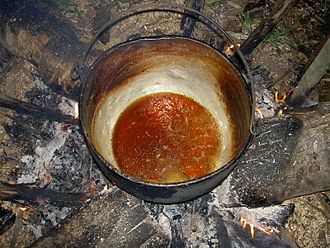 |
| Banisteriopsis caapi (The soul Vine) Photo: Wowbobwow12 [CC BY-SA 3.0 (Wikimedia Commons)] |
A pot of Ayahuasca brew Photo: Terpsichore [CC BY-SA 3.0 (Wikimedia Commons)] |
As well as extreme audio and visual hallucinations which can last many hours, drinking ayahuasca can lead to increased heart-rate, and to ‘the purge’ – intense vomiting and diarrhea.
Actually, that part has a medical purpose - the violent purging clears the body of worms and other tropical parasites which, without access to modern medicine, are difficult or impossible to remove otherwise. The drink itself is so potent because it not only contains the active drug DMT (from psychotria viridis), but the other plants in the mixture (e.g. Banisteriopsis caapi) contain ingredients called harmala alkaloids which are related to the molecules harmaline and harmine. These molecules are a type of drug called monoamine oxidase inhibitors (MAOIs), and they prevent the DMT being metabolized. Without the harmala alkaloids, DMT is ineffective when taken orally, as the body breaks it down into inactive components too rapidly.
Interestingly, harmine used to be called telepathine, because its use in native spirit rituals was (wrongly) associated with clairvoyance, precognition, telepathy, out-of-body travel, psychic diagnosis, psychic healing, and spirit communication.
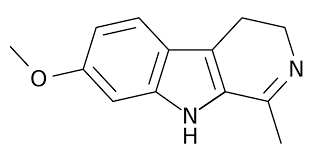 |
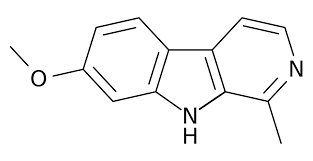 |
| Harmaline | Harmine |
So why is DMT different from all the other hallucinogenic drugs?You’re correct in that there are lots of psychotropic drugs, many of them mentioned above, that all produce similar hallucinations and the same sort of ‘trippy’ experiences. But DMT is unusual in that the experiences it provides are rather special. As well as the usual intensely coloured, rapidly moving display of visual images, plus auditory hallucinations and experiences of euphoria, calm, fear, and anxiety, which are common to many psychedelic drugs, DMT has been reported to induce a feeling that the user is surrounded by non-human intelligent-life forms that are a higher form of life, and which somehow control the fabric of the universe. The American author Terance McKenna coined the term ‘machine elf’ after smoking DMT in Berkeley in 1965. He said: ‘There's a whole bunch of entities waiting on the other side, saying "How wonderful that you're here! You come so rarely! We're so delighted to see you!" They're like jewelled self-dribbling basketballs and there are many of them and they come pounding toward you and they will stop in front of you and vibrate, but then they do a very disconcerting thing, which is they jump into your body and then they jump back out again and the whole thing is going on in a high-speed mode where you're being presented with thousands of details per second and you can't get ahold on [them ...] and these things are saying "Don't give in to astonishment", which is exactly what you want to do.’ |
 Terance McKenna in 1999. Photo: Jon Hanna [CC BY-SA 3.0 (Wikimedia commons)] |
|
Rick Strassman, a clinical associate professor of psychiatry at the University of New Mexico, has done a series of controlled experiments with patients using DMT. Some of his participants also described seeing mechanised wheels, gears and machinery when under the influence of DMT, as well seeing as more positive "external entities" which Strassman likened to the descriptions of angels in religious texts. Other researchers describe the "entities" or "beings" that are encountered by DMT users as having humanoid or animal form, with descriptions of dwarves, gnomes, elves, imps, etc., being common. It is speculated that this form of hallucination may be the cause of ‘alien abduction’ and other extraterrestrial encounter experiences. How so?Well, DMT is known to occur naturally in small amounts in human cerebrospinal fluid and in other human tissues, although the amounts are hard to quantify. As such, neurologists have suggested that DMT might be connected with dreaming; dreams are, after all, effectively hallucinations while you’re asleep. The proposal is that when in REM sleep, the levels of DMT in the brain might periodically increase to induce visual dreaming. Most ‘alien encounter’ reports come from people that say they were sleeping in home, and ‘woke up’ to find an alien at the foot of their bed. This is often associated with feelings of extreme anxiety, terror and bodily paralysis. Considering that DMT levels are likely to be at their highest when asleep, plus the descriptions of the ‘aliens’ as ‘intelligent humanoid entities, small but odd-looking’, which is remarkably reminiscent of the ‘machine elves’ seen by DMT users, the suggestions are that the encounter was simply a bad trip from excess DMT in the brain. People in REM sleep experience paralysis in order to prevent them acting out their dreams, so someone that was only partly in REM sleep would feel paralysed, while hallucinating at the same time. So alien encounters are nothing more than a dream, or a ‘bad DMT trip’?Possibly – just don’t tell Mulder and Scully… |
 An alien encounter, or just a bad trip-tamine? Image: Dan Meth / BuzzFeed |
![]()
![]()
![]() Back to Molecule of the Month page. [DOI:10.6084/m9.figshare.12053955]
Back to Molecule of the Month page. [DOI:10.6084/m9.figshare.12053955]